Septoria leaf spot is a foliar disease of tomatoes caused by fungal spores. It is one of the most destructive diseases of tomatoes, and the causal agent of septoria leaf spot is Septoria lycopersici. The infected leaves turn yellow and fall off from the plants. The severely infected plants are unable to grow and start reproduction growth. Therefore, the early detection and management of septoria leaf spot disease are crucial; otherwise, it results in tomato crop failure.
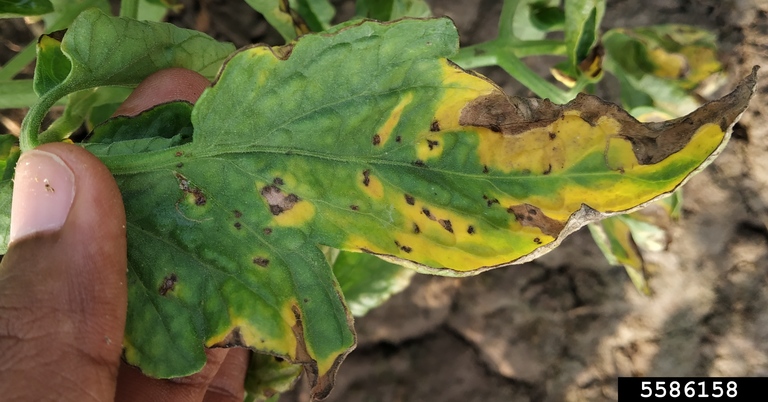
Septoria leaf spot on tomato leaves
The Septoria lycopersici pathogen is most common in the areas where wet, humid weather persists for a more extended period.
What Are the Septoria Leaf Spot Symptoms on Host Plants?
Septoria leaf spot is a foliar disease, and symptoms first appear on the underside of lower (older) leaves. The infection starts as dark spots with gray or tan centers on the bottom of tomato leaves.
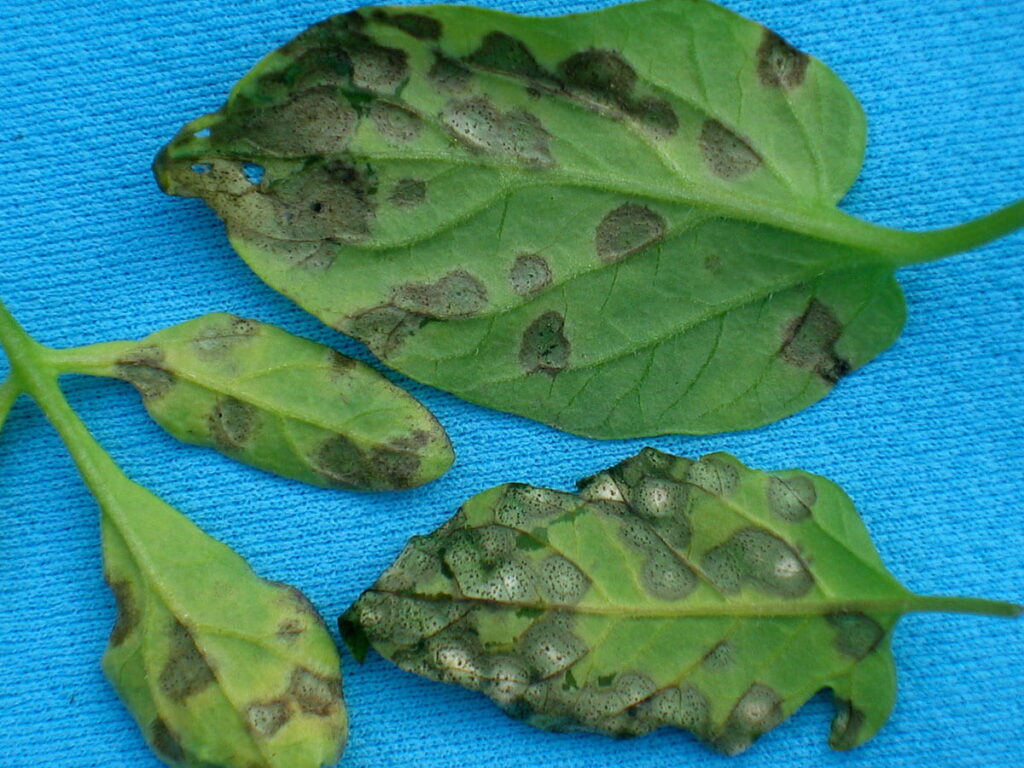
Dark-colored spots on the underside of tomato leave
These dark spots are circular, 1.6 to 3.2 mm in diameter, and surrounded by a yellow halo. As the disease progresses, these lesions merge, thus turning the entire leaf brown. In the case of severe infections, the diseased plants cannot set the first fruit and die.
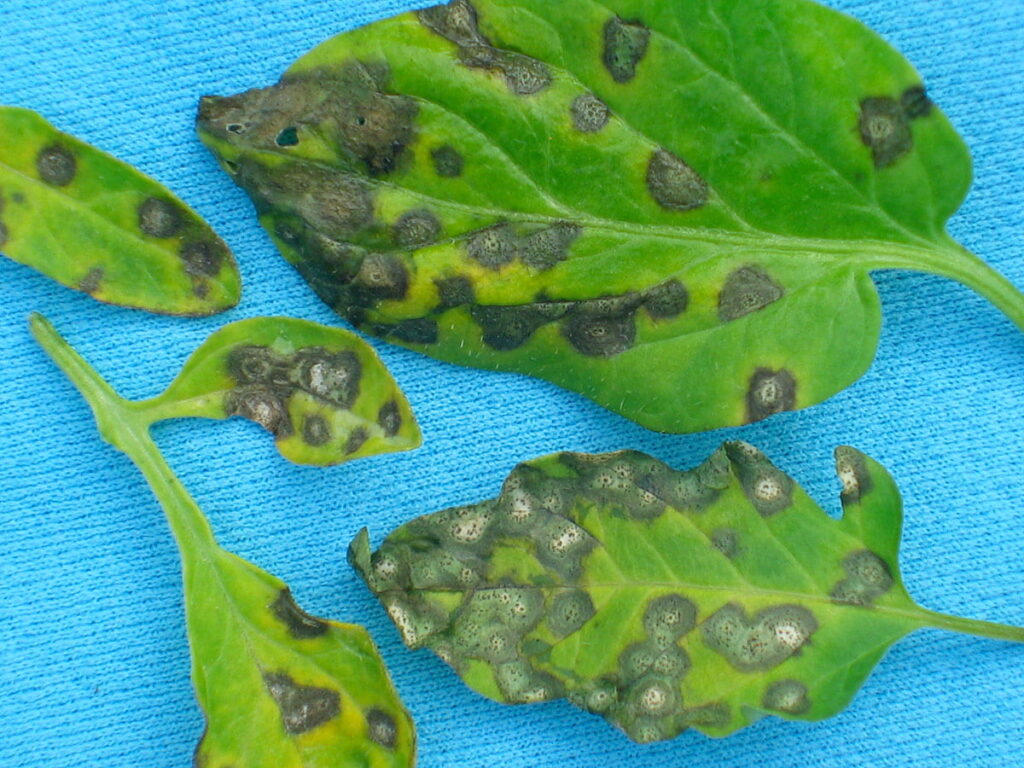
The dark spots on the upper side of the leaves of tomato plants
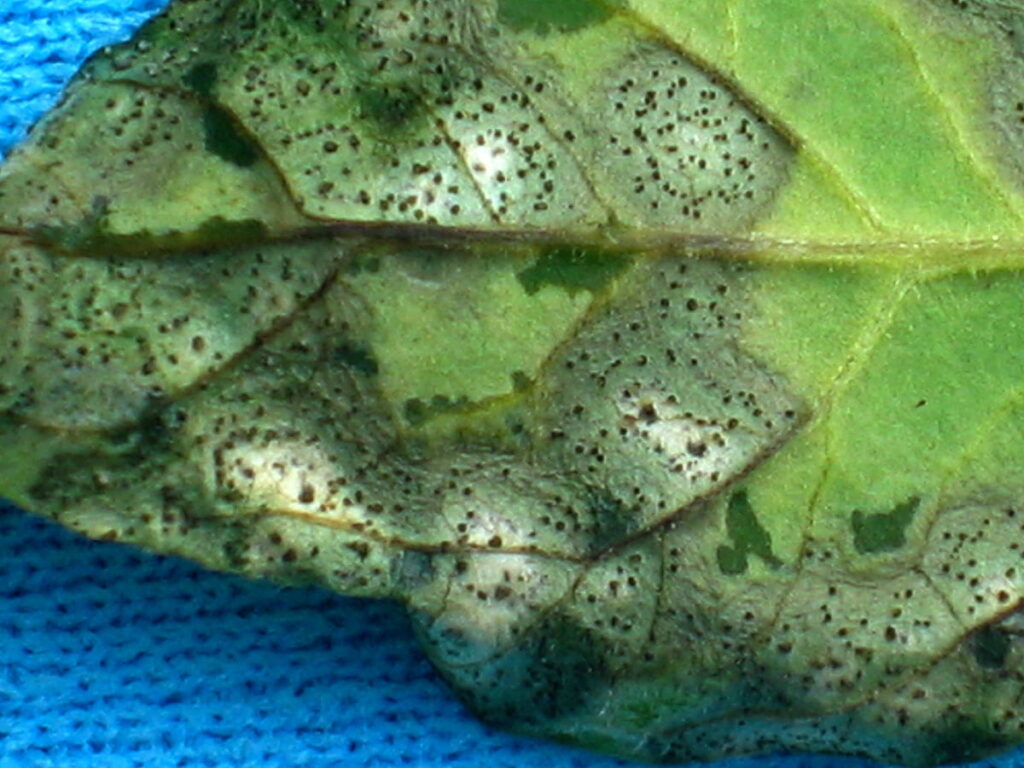
A magnified image of tomato plant leaves indicating the spore-bearing fruiting bodies of Septoria lycopersici.
While observing the underside of leaves with a magnifying glass, you may see the spore-bearing fruiting bodies that appear like pimples. The formation of these fruiting bodies distinguishes the septoria leaf blotch from other leaf spotting diseases.
Septoria leaf spot symptoms mostly appear on foliage and stems of affected plants. Moreover, this disease turns the leaf yellow and brown as the infection proceeds. During peak disease development, leaves dry out and fall onto the ground.
A plant without leaves cannot survive and will decline without reproductive growth. However, one bit of good news, this disease rarely impacts the tomato fruit.
Life Cycle of Septoria Leaf Spot Fungus
Fungal pathogens most often overwinter in the form of spores. Similarly, the septoria leaf spot pathogen overwinters in the infected plant debris as spores and waits for ideal germination conditions.
The fungus also overwinters on the garden equipment. Once the perfect conditions arrive, the fungal spores germinate and penetrate the host plant tissues to grow and multiply. The interference of fungal pathogens with host nutrients leads to the development of dark brown margins with tan centers.
The ideal conditions for septoria leaf spots (common tomato disease) are
- Warm temperature (60 to 80 F)
- Long periods of relative humidity
- Extended leaf wetness
These fungal spores spread through water splashes and air from one plant to another. So, cultural practices are effective strategies in controlling septoria leaf spot pathogens.
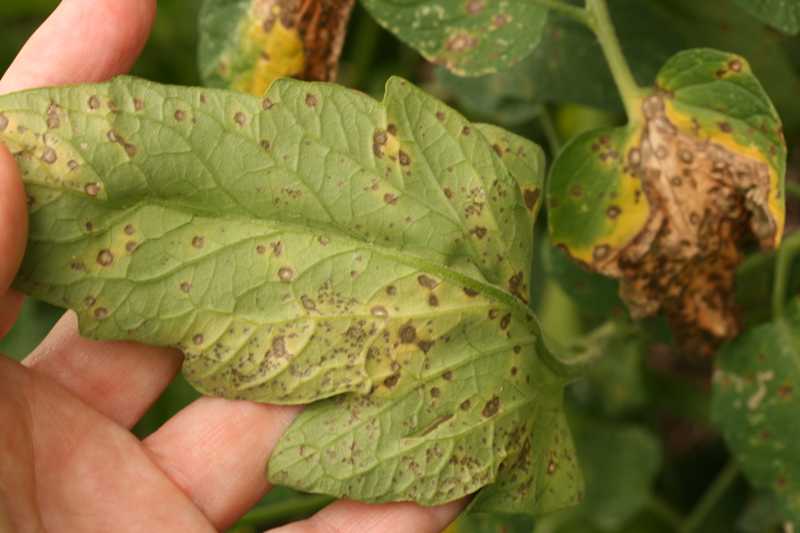
Small black fruiting bodies surrounded by a yellow halo
How to Control Septoria Leaf Spot Disease on Tomato Plants?
Controlling septoria leaf spots through integrated pest management approaches is the best solution. These are the best approaches to deal with plant diseases such as septoria leaf spot:
- Eliminate the infected plant material as soon as possible because it mainly acts as an infection source at the end of the season. Collect all the infected plant material or debris and dispose of it properly. Do not add diseased plant debris to the compost pile.
- Use disease-free seeds to plant tomatoes. It is best to treat seeds before planting in hot water to kill dormant pathogen spores.
- Plow the infected plants’ debris into the soil for the activity of microbes and add nutrients to the ground.
- Use septoria leaf spot resistant varieties such as the tomato variety “Iron Lady,” which has complete resistance to leaf spot pathogen.
- Avoid overhead watering to stop the disease cycle and maintain good air circulation through the proper spacing between plants. Keep the garden clean and remove dead and fallen leaves.
- Water the tomato plants in the early morning and encourage caging of plants for rapid drying of leaves.
- Use plastic mulch or other material near the base of the plant to avoid the splashing soil (a source of infection), which may contain pathogen spores.
- Use a drip irrigation system to discourage overwatering, providing the septoria leaf blotch pathogen with ideal germination conditions.
- Remove the lower infected leaf manually from the tomato plants and bury them instantly to stop the further spread of the disease.
- Use crop rotation to avoid the disease cycle for the following year. For example, avoid planting tomato crops on the same site for the next few years so that the pathogen will have no option of survival.
- Control alternate hosts for septoria leaf spots such as the members of the Solanaceae family, jimson weed, and horsenettle.
Use Fungicides to Kill Septoria lycopersici
The spray with fungicides will not stop or kill the pathogen, but the pros are that it will prevent new infection growth.
The following table is a description of various fungicides with their application interval:
| Fungicides | Application Interval |
| Mancozeb | 7 to 14 days |
| Ziram | 7 to 14 days |
| Tetraconazole | Before disease arrival, with two consecutive applications |
| Copper-based fungicides | 7 to 14 days |
| Chlorothalonil | 7 to 14 days |
| Hydrogen dioxide | 14 days |
| Azoxystrobin | 7 to 14 days |
| Bacillus mycoides | 14 days |
FAQs
How Do You Treat Leaf Spots Naturally?
The leaf spots can be controlled through the following remedies:
- Two tablespoons of baking soda
- One tablespoon of dish soap
- Four cups of water
Mix all the ingredients in a bowl and pour into a spray bottle. Spray on all garden plants to avoid the infection of leaf spots and early blight (a bacterial disease).
The second remedy includes
- One tablespoon of baking soda
- Two tablespoons of dish soap (not detergent)
- Two tablespoons of vegetable oil per gallon of water
Mix all ingredients in a bowl thoroughly and pour into a spray bottle for application.
Does Neem Oil Treat Septoria Leaf Spot?
Neem oil works as miticidal, fungicidal, and insecticidal. Therefore, it can treat septoria leaf spot pathogens. To control Septoria lycopersici.
- Mix one tablespoon of neem oil and one tablespoon of dish soap per gallon of water.
- Pour the mixture into a spray bottle and apply to plants at 7 to 14 days intervals.
- Do not apply neem oil at midday when temperatures are high.
What is Damping Off in Plants?
Damping-off is caused by soil-borne fungal pathogens or a mold that infects plants’ young roots and seedlings. It causes the rotting and disintegration of roots and stems in and below the soil. The rotting of infected plants attracts the secondary pathogens that cause root rot and crown rot. The wet and humid weather conditions are responsible for this disease. If this disease goes unnoticed, it leads to the killing of whole seedlings and economic losses.
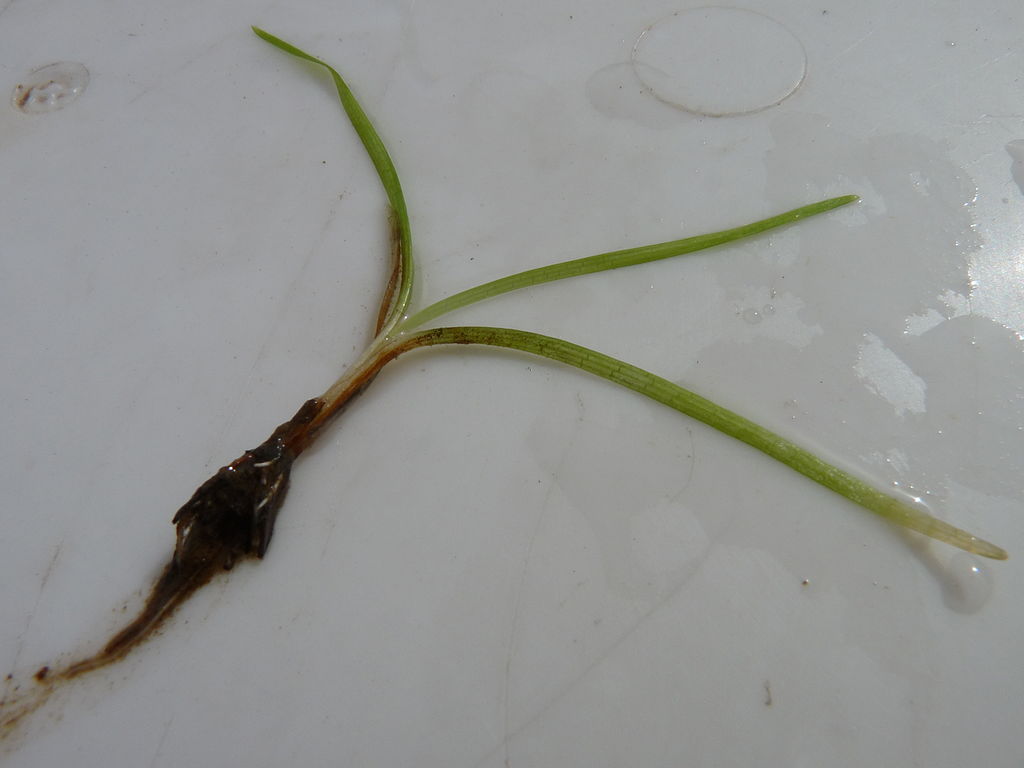
Damping-off in young seedlings
Does Septoria Live in Soil?
Septoria does not live in soil, but it overwinters in plant debris and waits for ideal conditions to start an infection. The ideal conditions for this pathogen are warmer temperatures with an extended period of moisture.
What is the Best Fungicide For Leaf Spots?
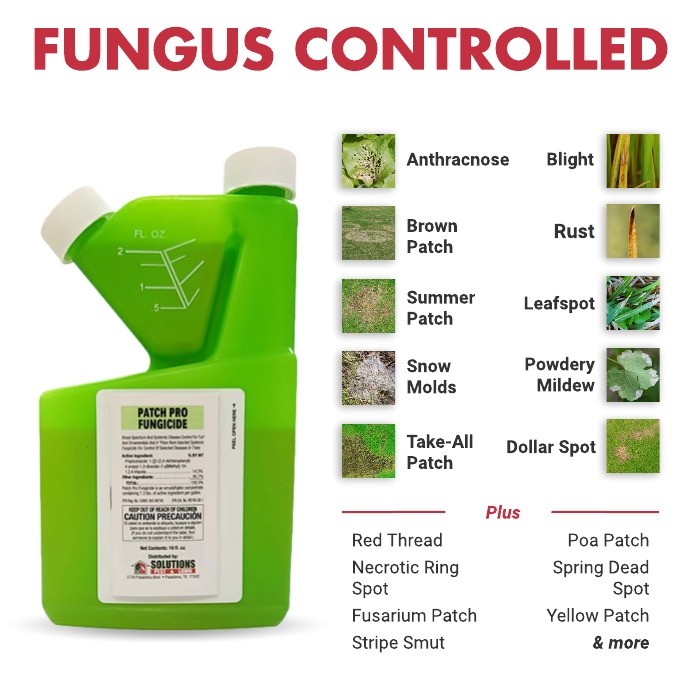
Patch Pro—to control leaf spot pathogen plus all-rounder against pathogens
The top recommendation for the best fungicide for leaf spots is Patch Pro. This fungicide contains propiconazole as an active ingredient to kill the pathogen. It also prevents the spread of spores toward the neighboring plants. Patch Pro is also cost-effective and more affordable.
How Do You Treat Leaf Spots?
The best approach is prevention to treat septoria leaf spots from tomato plants. So, the preventive measures include
- Removal of infected plant parts at the start and end of the growing season
- Discourage overhead watering practices because they support the pathogen infection cycle
- Use organic mulches to prevent the travel of spores toward neighboring plants
- Apply baking soda and neem oil spray to garden plants to avoid spotting new growths
- Use crop rotation, planned fertilizer applications, and copper-based fungicides to kill septoria and leaf blotch pathogen
Sources for Further Reading
- Septoria Leaf Spot. (2021, September). Extension | West Virginia University. Retrieved April 1, 2022, from https://extension.wvu.edu/lawn-gardening-pests/plant-disease/fruit-vegetable-diseases/septoria-leaf-spot
- Septoria Leaf Spot of Tomato. (n.d.). Missouri Botanical Garden. Retrieved April 1, 2022, from https://www.missouribotanicalgarden.org/gardens-gardening/your-garden/help-for-the-home-gardener/advice-tips-resources/pests-and-problems/diseases/fungal-spots/septoria-leaf-spot-of-tomato.aspx
- Septoria leaf spot on tomatoes | Vegetable Pathology – Long Island Horticultural Research & Extension Center. (n.d.). Cornell University. Retrieved April 1, 2022, from https://blogs.cornell.edu/livegpath/gallery/tomato/tomato-septoria-leaf-spot/
- Cooperative Extension: Insect Pests, Ticks, and Plant Diseases. (2021, August 31). Septoria Leaf Spot of Tomato – Cooperative Extension: Insect Pests, Ticks, and Plant Diseases – University of Maine Cooperative Extension. Retrieved April 1, 2022, from https://extension.umaine.edu/ipm/ipddl/publications/5088e/
Now that you know how to manage septoria leaf spot, make sure to read our other articles:
Vegetable Downy Mildew Disease: Its Identification and Management for Good!
Identification and Control of Rust Fungus by Natural and Chemical Ways
Why Are The Leaves Turning Yellow? 8 Reasons Why Your Pothos Is Changing Color







